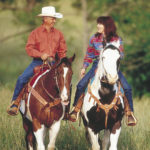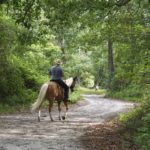Reining is a judged event designed to show the athletic ability of a ranch-type horse within the confines of a show arena. In NRHA competition, contestants are required to run one of10 approved patterns, included in the NRHA handbook. Each pattern includes small slow circles, large fast circles, flying lead changes, rollbacks over the hocks, 360 degree spins done in place, and exciting sliding stops that are the hallmark of the reining horse.

The following are maneuvers as defined by the NRHA:
Walk-In
The walk-in brings the horse from the gate to the center of the arena to begin the pattern. The horse should appear relaxed and confident. Any action which may create the appearance of intimidation, including starting and stopping, or checking, is a fault, which shall be marked down according to the severity in the first maneuver score.
Circles
Circles are maneuvers at the lope, of designated size and speed, which demonstrate control, willingness to guide, and degree of difficulty in speed and speed changes. Circles must at all times be run in the geographical area of the arena specified in the pattern description and must have a common center point.
There must be a clearly defined difference in the speed and size of a small, slow circle, and a large fast circle; also the speed and size of small, slow, right circles should be similar to the small, slow, left circles.
Likewise, the speed and size of the large, fast, right circles should be similar to the large, fast, left circles.
Spins
Spins are a series of 360-degree turns, executed over a stationary, inside hind leg. Propulsion for the spin is supplied by the outside, rear leg and front legs, and contact should be made with the ground and a front leg. The location of hindquarters should be fixed at the start of the spin and maintained throughout the spins. It’s helpful for a judge to watch for the horse to remain in the same location, rather than watching for a stationary inside leg. This allows for easier focus on the other elements of the spin (ie., cadence, attitude, smoothness, finesse, and speed).
Hesitate
To hesitate is the act of demonstrating the horse’s ability to stand in a relaxed manner at a designated time in a pattern. In a hesitation, the horse is required to remain motionless and relaxed. All NRHA patterns require a hesitation at the end of the pattern to demonstrate to the judge(s) completion of the pattern.
Lead Changes
Lead changes are the act of changing the leading legs of the front and rear pairs of legs at a lope, when changing the direction traveled. The lead change must be executed at a lope with no change of gait and be performed in the exact geographical position in the arena specified in the pattern description. The change of front and rear leads must take place within the same stride to avoid penalty.
Rundowns and Runarounds
Rundowns occur in a pattern before a stop. They are runs through the middle of the arena and along the side and ends of the arena. Rundowns and runarounds should demonstrate control and gradual increase in speed to the stop.
Stops
Stops are the act of slowing the horse from a lope to a stop position by bringing the hind legs under the horse in a locked position, sliding on the hind feet.
The horse should enter the stop position by bending the back, bringing the hind legs further under the body while maintaining forward motion and ground contact and cadence with front legs. Throughout the stop, the horse should continue in a straight line while maintaining ground contact with the hind feet.
Rollbacks
Rollbacks are the 180-degree reversal of forward motion completed by running to a stop, rolling (turning) the shoulders back to the opposite direction over the hocks and departing in a canter, as one continuous motion. The NRHA handbook states no hesitation; however, a slight pause to regain footing or balance should not be deemed hesitation. The horse should not step ahead or back up prior to rolling back.
Backups
A backup is a maneuver requiring the horse to be moved in a reverse motion in a straight line at a required distance; at least 10 feet.
For more information on reining, go to the National Reining Horse Association.





